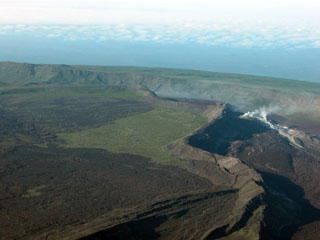Report on Sierra Negra (Ecuador) — 6 June-12 June 2018
Smithsonian Institution / US Geological Survey
Weekly Volcanic Activity Report, 6 June-12 June 2018
Managing Editor: Sally Sennert.
Please cite this report as:
Global Volcanism Program, 2018. Report on Sierra Negra (Ecuador) (Sennert, S, ed.). Weekly Volcanic Activity Report, 6 June-12 June 2018. Smithsonian Institution and US Geological Survey.
Sierra Negra
Ecuador
0.83°S, 91.17°W; summit elev. 1124 m
All times are local (unless otherwise noted)
On 8 June IG reported a continuing high level of seismicity at Sierra Negra, characterized by a larger number and magnitude of earthquakes, indicating magma movement. The number of events per day had been significantly increasing since mid-2016. In the previous 10 days there was an average of 42 local events/day; on 25 May there were 104 events, the largest number of earthquakes per day recorded since 2015. In addition, in a 24-hour period during 7-8 June there were a total of 48 volcano-tectonic events, two long-period events, and three hybrid earthquakes; a M 4.8 long-period earthquake was recorded at 0715 on 8 June. The earthquake epicenters were mainly located on the edges of the crater, in two NE-SW trending lineaments; the first covered the N and W edges of the crater and the second went from the NE part around to the S edge. Data showed very large deformation at the caldera’s center, compared with lower levels of deformation outside of the caldera.
Geological Summary. The broad shield volcano of Sierra Negra at the southern end of Isabela Island contains a shallow 7 x 10.5 km caldera that is the largest in the Galápagos Islands. Flank vents abound, including cinder cones and spatter cones concentrated along an ENE-trending rift system and tuff cones along the coast and forming offshore islands. Although it is the largest of the five major Isabela volcanoes, it has the flattest slopes, averaging less than 5° and diminishing to 2° near the coast. A sinuous 14-km-long, N-S-trending ridge occupies the west part of the caldera floor, which lies only about 100 m below its rim. The Volcán de Azufre fumarolic area lies within a graben between this ridge and the west caldera wall. Lava flows from a major eruption in 1979 extend all the way to the north coast from circumferential fissure vents on the upper northern flank.
Source: Instituto Geofísico-Escuela Politécnica Nacional (IG-EPN)

